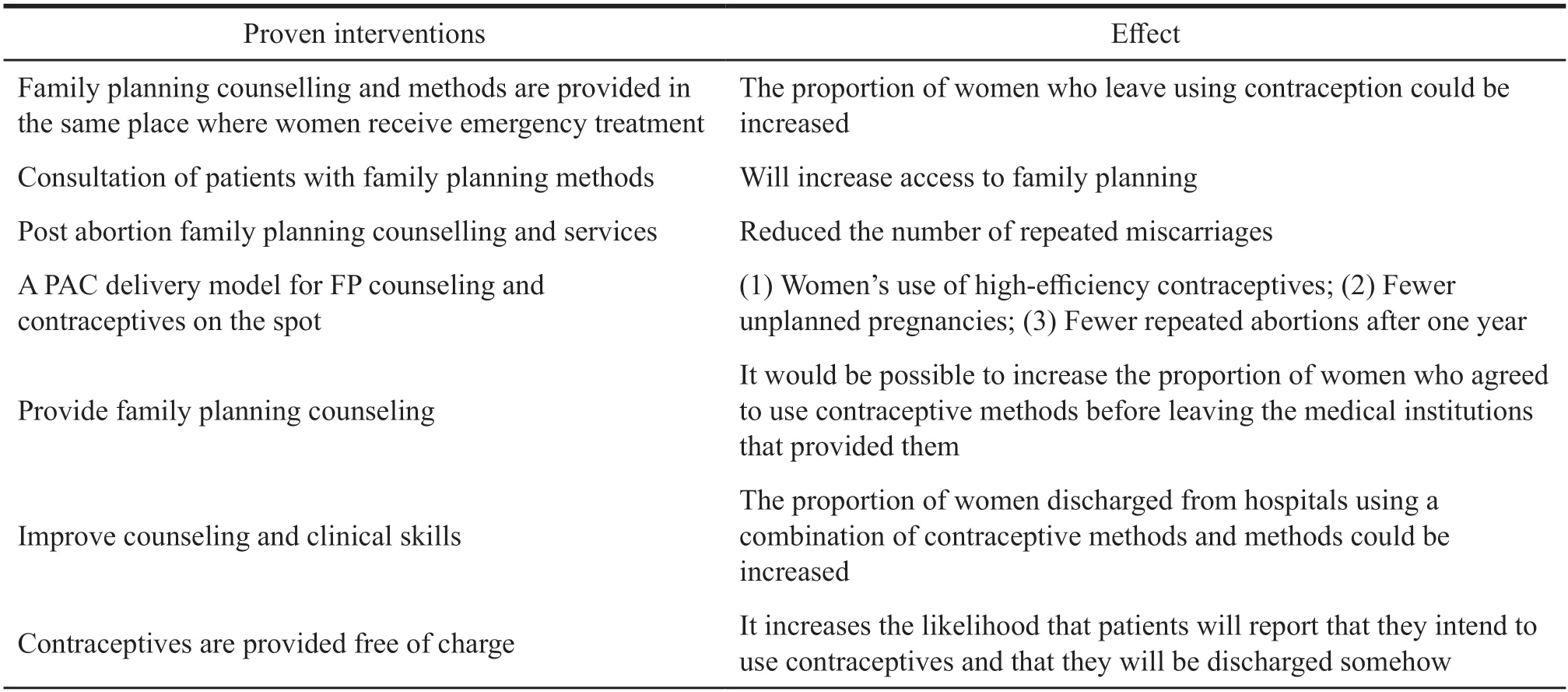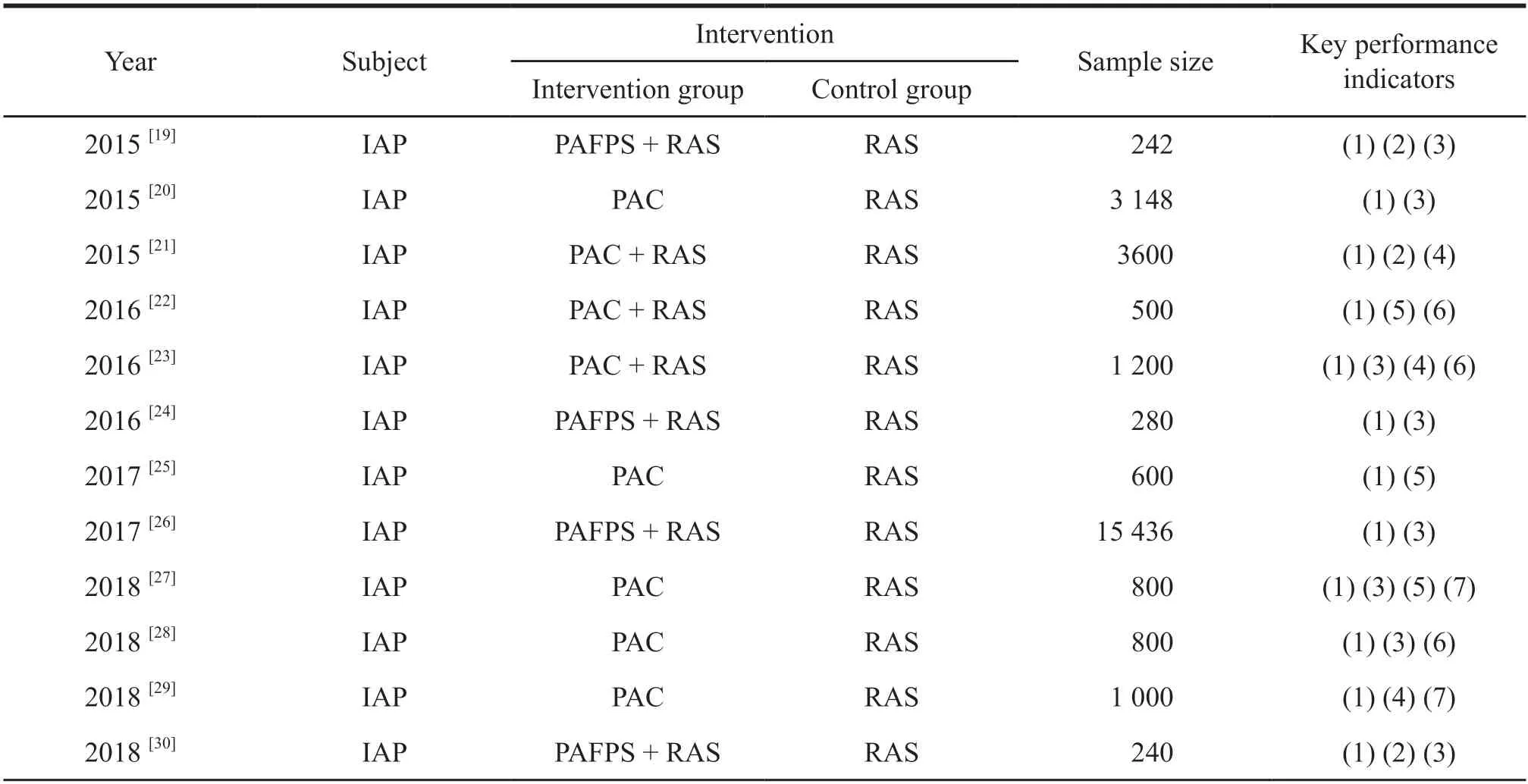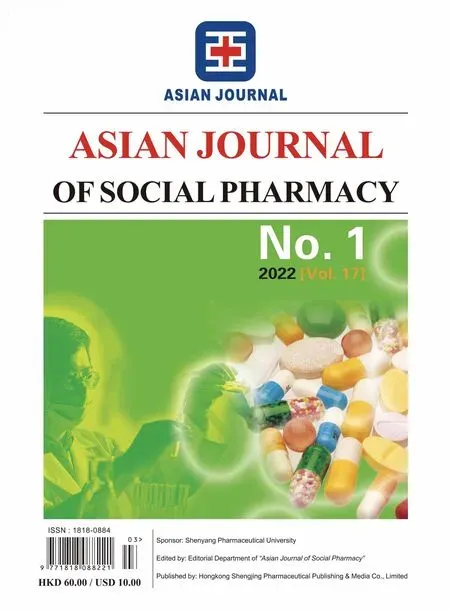A Review of the Development and Effect of Contraceptive Counseling After Abortion
Qiu Yu,Zhang Fang
(School of Business Administration,Shenyang Pharmaceutical University,Shenyang 110016,China)
Abstract Objective To introduce the background and development of post-abortion services such as contraceptive counseling at home and abroad,and its important role for women so as to provide a reference for the further popularization of this service in China.Methods Chinese and English databases such as CNKI,WanFang Database,VIP,PubMed,and Web of Science were searched to find relevant studies on the implementation of post-abortion service,including post-abortion family planning and post-abortion contraceptive counseling in China.And then the literature on the implementation effect of post-abortion contraceptive counseling and related services was reviewed in China.Results and Conclusion The post-abortion contraceptive counseling service can effectively improve the reproductive health of the patients with induced abortion and the level of knowledge about contraception and birth control,so as to change the contraceptive behavior and adverse psychological state of the patients.Besides.it can guide patients to use more long-term and effective contraceptive measures,thereby reducing the occurrence of unintended pregnancy and repeated abortion.Standardized contraceptive counseling and related services can also improve patient satisfaction.According to the development and implementation effect of post-abortion service and post-abortion contraceptive counseling at home and abroad,it is necessary to further promote post-abortion contraceptive counseling service in the future.Much consideration should be given to carrying out a health technical assessment of the standardized post-abortion contraceptive counseling service as well as its implementation costs.Therefore,medical institutions will have a reference to carry out standardized post-abortion contraceptive counseling service.
Keywords:family planning service after abortion;post-abortion care;post-abortion contraceptive counseling;development history
Post abortion contraceptive counseling and related services are important parts of post-abortion care (PAC).PAC,also known as post-abortion nursing services or post-abortion care services,is a standardized service that treats abortion-related complications,and provides post-abortion family planning counseling and services to prevent unplanned pregnancies and abortions,thereby reducing the maternal death rate[1].The concept of PAC was first proposed by International Project Assistance Services (IPAS) in 1991,and the original model of PAC was released in 1994.After continuous exploration and practice,in 2002 the international women’s health coalition proposed an expanded and updated model of PAC.The core components mainly include post-abortion community services,post-abortion counseling services,post-abortion complications treatment services,postabortion family planning service (PAFPS) and postabortion reproductive health and other comprehensive health services[2,3].Studies have shown that PAFPS is the most important link,and the abortion rate decreased by 25%-50% in the full implementation of PAFPS in more than 40 countries[4,5].For many abortion patients,the lack of family planning counselling and services can quickly lead to another abortion,as fertility is restored within two to three weeks after the abortion or induced abortion[6].The World Health Organization (WHO)recommends that“information on contraception should be provided to all women before leaving health care facilities after an abortion and advice and methods for post-abortion contraception (including emergency contraception) should be provided[7].
1 Review method
1.1 Literature retrieval of the development process and implementation of contraceptive counseling service after abortion
Chinese and English databases such as CNKI,Wanfang Database,VIP,PubMed,and Web of Science were searched.The time limit for searching Chinese databases is from January 2010 to August 2020.The following words such as post-abortion care/ post-abortion family planning/ post-abortion contraceptive counseling and status/ implementation/development were used as the theme words and keywords for the search.Meanwhile,the search time limit for English databases is from January 2000 to August 2020,and post-abortion care/ family planning service were used as the keywords for the search.A total of 1 190 articles were searched,and 737 articles were found after checking.71 articles were screened according to the titles and abstracts,and 12 articles were finally included after reading the full text.
1.2 Literature on the effect of contraceptive counseling service after abortion in China
CNKI,Wanfang Database and VIP were searched and post-abortion care/ post-abortion family planning and effect/ intervention were used as the keywords,a total of 131 papers were screened according to the titles and abstracts.67 papers were obtained,excluding non-core journals and studies for specific population groups.Finally,18 papers were included after reading the full text.
2 Development history and implementation effect of international contraceptive counseling service after abortion
2.1 Development history of international contraceptive counseling service after abortion
IPAS introduced the term PAC in 1993,and after the United Nations International Conference on Population and Development held in Cairo in 1994,different nations began to officially launch programs in PAC[8].The international post-abortion contraceptive counseling service was developed as an important part of family planning service,and the PAC global program funded by the United States Agency for International Development (USAID) was developed in three main stages.The first stage is the initial stage (1990-2000)of the post-abortion contraceptive counseling program.The post-abortion contraceptive counseling service was not effectively implemented at this stage.After USAID initially determined the three-factor model of the PAC,the program was funded and implemented through international cooperation.At this stage,the treatment of post-abortion complications is the main service in different nations.The second phase is the expansion and revision of the PAC program (2001-2010),which began in 2001 with a global assessment made by USAID on the first phase of the PAC program.The objective was to undertake a comprehensive and thorough review and analysis of the current programmatic and technical issues.The assessment showed that the greatest success was in the treatment of post-abortion complications,but voluntary family planning counselling and services were not implemented.Since 2004,USAID has revised its PAC model,expanding it from three elements to five,emphasizing immediate post-abortion family planning counseling and voluntary family planning services,strategic reproductive health services,and community empowerment.A long-term strategy for PAC projects was developed in 2005.And in collaboration with six key countries,the projects began to be decentralized to the health center level and to promote community participation.From 2006 to 2008,USAID developed and launched the global PAC resource pack for countries that initiated or improved PAC programs.The development of the global PAC resource pack prepared PAC for further global promotion.In 2009,international organizations such as USAID and the International Federation of Women released a joint consensus statement,“Post Abortion Family Planning:A Critical Component of PAC”.In the following year,it published a propaganda article“Post Abortion Family Planning:Solving the Cycle of Repeated Unwanted Pregnancies and Abortions”.This phase marked that family planning counseling and related services began to get the attention of all countries.It is at this stage that China formally introduced PAC with the help of EU.The third phase is the comprehensive promotion of postabortion contraceptive counselling and related services(2012-2018).By 2013,all 40 members countries of the International Federation of Gynaecology and Obstetrics had included post-abortion contraception in their action plans.By 2017,immediate post-abortion contraceptive services had been provided in teaching hospitals in 46 participating countries.Updated guidelines are being used in eight Caribbean and Central American countries,with a focus on post-abortion counselling and the provision of voluntary contraceptive methods[9].
2.2 Implementation effect of international postabortion contraceptive counseling service
In 2007,USAID published the first global PAC study summary“Policy and Programme Guidelines for Post Abortion Care”,which reviewed PAC literature from 1994 to 2003.The second edition is based on the first one and it includes more detailed findings that address the cycle of unwanted pregnancies and repeated abortion.Two PAC studies examined more than 550 articles and reports published between 1994 and 2013,representing 20 years of PAC research.The main interventions with regard to family planning counselling and related services proved to be supported by sufficient evidence and their effectiveness are shown in Table 1.In addition,other factors contributing to the successful implementation of post-abortion family planning counselling services include the improvement of family planning counselling skills and staff training,the provision of auxiliary tools and client education materials[9-11].

Table 1 Intervention measures and effect of family planning counseling and service

Continued Table 1
3 Implementation of contraceptive counseling service after abortion in China
3.1 Development of contraceptive counseling service after abortion in China
The PAC in China is mainly the PAFPS,which promotes and improves the cognition and behavior of contraception among women of childbearing age through consultation,follow-up and education.It guides women of childbearing age to implement contraception immediately after abortion,and in particular to promote the use of long-term and highly effective contraception to reduce the rate of repeated abortions[12].From the perspective of development history,China introduced PAC in 2004 with the support and cooperation of the European Union in accordance with the healthy reproductive strategy issued by WHO.After the initial development,in 2011,the Branch of China Medical Family Planning Association formulated and issued the first“Guide to PAFPS”.Some scholars interpreted the contents of the guide,emphasizing that individual consultations should be the main form of service,and collective counseling should be carried out only as a supplementary form,with a clear focus on the establishment and improvement of advisory services.At the same time,the Yi Ai Foundation was established.With the support of the charity fund and under the guidance of PAFPS,the national PAC project of“Caring for Women’s PAC”was initiated[13-15].From 2012 to 2016,with funding from the seventh framework of the European Commission,China further promoted international cooperation in the four-year INPAC project,namely,the PAC and the European Union’s International Cooperation Project.Its aim is to explore a reasonable way to combine PAFPS with other services in China’s hospitals[16].In 2018,the National Health Commission issued the“Regulations on Post Abortion Contraceptive Services”and related documents,which were more specific than the guidelines on family planning services.It further promoted the standard process of China’s PAC[17,18].
3.2 The methods and evaluation indexes of carrying out post-abortion contraceptive counseling services in China
According to the contents of the above guidelines and the research results,there are few clinical studies on post-abortion contraceptive counseling services in China.China’s standardized post-abortion contraceptive counseling and related services are carried out in the form of PAC and PAFPS.Because both of them focus on the post-abortion contraceptive counseling services,and the domestic PAC is mainly in the form of PAFPS,PAC is sometimes considered as a high-quality service of family planning.The one-to-one contraceptive counseling service at the initial visit before operation and the first followup after operation are considered to be the key link of PAC and PAFPS.Staff of family planning clinics or care clinics are required to provide counsellingbased services to women after abortion,accompanied by the distribution of contraceptives and educational materials.Domestic literature on the effect of postabortion contraceptive consulting services can be divided into two main classes.One is that hospitals carry out family planning consultation and other services in the form of care after abortion.The other is that hospitals carry out the post-abortion contraceptive counseling and related services according to the guidelines and specifications in combination with the actual situation.At present,the commonly used indicators to evaluate the abortion items in the world mainly include four categories:the rate of repeated abortion,the level of sexual and reproductive health knowledge,the rate of contraceptive implementation,and service satisfaction.The more extensive investigation on post-abortion consultation and related services in China mainly includes the following seven aspects:the rate of unexpected pregnancy,unwanted pregnancies and repeated abortions,knowledge of sexual and reproductive health,improved contraceptive behavior (use of contraceptives,active contraception,contraceptive compliance,contraceptive prevalence and correct use rate),service satisfaction,psychological states such as anxiety and depression,the utilization rate of long-acting contraceptive measures and high-efficiency contraceptive measures,and incidence of postoperative complications.
3.3 Implementation effect of post-abortion contraceptive counseling service
After literature search,18 papers related to the effect of PAC and PAFPS were included.Among them,13 papers were related to the effect of PAC and 5 papers were related to the effect of PAFPS.The results of the literature included are shown in Table 2.According to the results of the literature included,the standardized post-abortion contraceptive counseling service can effectively improve the level of patients’reproductive and contraceptive knowledge,their contraceptive behavior,and psychological state.Additionally,it can guide patients to use more longterm and efficient contraceptive measures,thereby reducing the occurrence of unintended pregnancy and repeated abortion.Meanwhile,standardized contraceptive counseling and related services can also improve patients’ satisfaction with services.

Table 2 Inclusion of literature on effect evaluation of PAC and PAFPS

Continued Table 2
4 Discussion
It can be seen from the above literature that domestic medical institutions have achieved satisfactory results in clinical practice for PAC or PAFPS.Compared with the international community,the research on PAC in China started relatively late.The time from 2004 to 2011 is the initial stage of China’s PAC,during which China had completed the introduction of PAC.The release of post-abortion family planning guidelines marks the beginning of the standardized PAFPS in China.The time from 2011 to 2018 is the development stage of China’s PAC.The completion of the INPAC project in cooperation with the EU at this stage marks significant progress for China to find a reasonable way to combine PAFPS with abortion services in hospitals.During the same period,PAC initiated by the Chinese Association of Medical Family Planning was given priority in some hospitals.By the end of 2018,799 medical institutions in more than 300 cities at the prefectural level and above had set up PAC clinics,which formed a certain demonstration effect[37].After 2018,China’s postabortion contraceptive counseling service is facing further promotion.The“Regulations on Post Abortion Contraceptive Services”issued by the National Health Commission further standardize post-abortion family planning consultation and services.From the family planning service guide to the contraceptive service regulation,it is emphasized that PAC should prevent the recurrence of induced abortion while playing its therapeutic role.
From the development history of post-abortion contraceptive counseling service,we can find that integrating PAC into global and national plans is a slow course.The integration of new medical technology or medical service into the health service system generally requires the assessment of health technology to determine its safety and effectiveness.At the same time,the capacity of health system should be further considered for health economic evaluation and budget impact analysis.China’s PAFPS has not yet been fully standardized and the providers of PAFPS are hospitals.At present,community medical institutions have not launched PAFPS yet,and there is a certain gap compared with developed countries.After years of practice,the key points and standards for the work of postabortion contraceptive counseling services in China are relatively clear.However,as it is a project within the hospital,the fund is generally provided by the project sponsor.Hospitals lack corresponding financial support and assessment,and there is no relevant health technology assessment.Besides,the project fee and implementation cost are not clear,so some hospitals lack enthusiasm for the training and consulting project.In order to further promote the project of post-abortion contraceptive counseling,the health technology assessment of postabortion contraceptive counseling service should be carried out.Because of the safety and efficacy of post-abortion contraceptive counseling and related services,numerous studies at home and abroad have demonstrated their value in clinical practice.Therefore,family planning services have been recognized as a cost-effective intervention.Because it will reduce the cost of health care,family planning counseling and services are typically cheaper than the treatment cost of PAC.A World Bank study found that the annual cost of PAC treatment services is four times more than that of family planning services[38].The health technology assessment should focus on further accounting for the implementation costs of post-abortion contraceptive counselling services.A study shows that some developing countries,such as Ethiopia,Uganda,Rwanda and Colombia have used special customization of cost accounting method for medical costs of abortion.At present,there is no research on the implementation cost of post-abortion contraceptive counseling services in China.We should consider further accounting for the implementation cost of the service so as to provide a reference for medical institutions to carry out the services[39].
5 Conclusion
According to the development history and implementation effect of PAC and post-abortion contraceptive counseling service at home and abroad,it is necessary to further promote them nationwide in the future.It should be considered to evaluate the health technology of the standardized post-abortion contraceptive counseling service in China,and calculate its implementation cost,so as to provide a reference for medical institutions to carry out the standardized post-abortion contraceptive counseling service.
- 亚洲社会药学杂志的其它文章
- Research and Suggestions on the Development of Smart Hospital -Taking Hospital A in Liaoning for Example
- The Development Opportunities and Dilemmas of Telemedicine-Base on the Perspective of Medical Resource Distribution
- Development Status and Enlightenment of Precision Medicine in China
- Design of Pharmaceutical Care Process for Retail Pharmacies Based on Pareto Analysis
- Study on the Application of Quality Risk Management on Drug Collinear Production
- Analysis and Enlightenment of Pediatric Drug Registration Data in China

